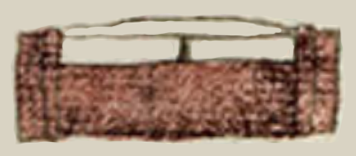teponaztli (CST34)
This painting of the simplex glyph for the term teponaztli (a wooden drum that is made from a hollowed-out log) has an H-shape carved into the top which is struck in different places for different sounds. The companion Nahuatl text notes that this drum was purchased for 10 pesos because it was needed at the royal palace (tecpan).
Stephanie Wood
This is an Indigenous drum that is still played in some situations in Mexico.
Here is a demonstration with audio of someone playing a teponaztli. For more on the Codex Sierra, see Kevin Terraciano’s study (2021).
Stephanie Wood
1550–1564
Jeff Haskett-Wood
tambores, madera, horizontal
This Post-Classic (1325–1521 C.E.) teponaztli is located in the Museo Nacional de Historia, Chapultepec Park, Mexico City. It is from Tlaxcallan (modern day Tlaxcala). It is a hollowed trunk with slits cut into it, and it has relief carvings on the exterior. Photo by S. Wood, 29 April 2025.

teponaz(tli), a horizontal log drum, https://nahuatl.wired-humanities.org/content/teponaztli
un tambor horizontal de madera, o un tambor de tronco
Stephanie Wood
Códice Sierra-Texupan, plate 34, page dated 1560. Origin: Santa Catalina Texupan, Mixteca Alta, State of Oaxaca. Kevin Terraciano has published an outstanding study of this manuscript (Codex Sierra, 2021), and in his book he refers to alphabetic and “pictorial” writing, not hieroglyphic writing. We are still counting some of the imagery from this source as hieroglyphic writing, but we are also including examples of “iconography” where the images verge on European style illustrations or scenes showing activities. We have this iconography category so that such images can be fruitfully compared with hieroglyphs. Hieroglyphic writing was evolving as a result of the influence of European illustrations, and even alphabetic writing impacted it.
https://bidilaf.buap.mx/objeto.xql?id=48281&busqueda=Texupan&action=search
The Biblioteca Digital Lafragua of the Biblioteca Histórica José María Lafragua in Puebla, Mexico, publishes this Códice Sierra-Texupan, 1550–1564 (62pp., 30.7 x 21.8 cm.), referring to it as being in the “Public Domain.” This image is published here under a Creative Commons license, asking that you cite the Biblioteca Digital Lafragua and this Visual Lexicon of Aztec Hieroglyphs.




